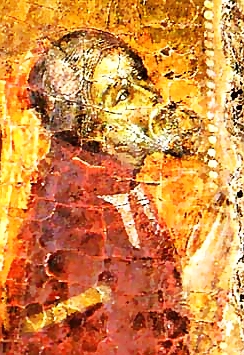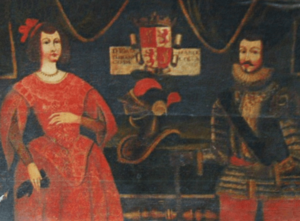Juan Manuel facts for kids
Quick facts for kids Juan Manuel |
|
|---|---|
 |
|
| Don Juan Manuel, Prince of Villena | |
| Spouse(s) | Elizabeth of Majorca Constance of Aragon Blanca de La Cerda y Lara |
| Issue | |
|
|
| Noble family | Castilian House of Ivrea |
| Father | Manuel of Castile |
| Mother | Beatrice of Savoy |
| Born | 5 May 1282 Escalona |
| Died | 13 June 1348 (aged 66) Peñafiel Castle |
Don Juan Manuel (born May 5, 1282 – died June 13, 1348) was an important Spanish writer from the Middle Ages. He was the nephew of Alfonso X of Castile, a powerful king. Juan Manuel inherited a large area called the Lordship of Villena from his father. This made him very rich and powerful. He even made his own money, just like kings did!
Juan Manuel married three times. He chose his wives and arranged marriages for his children to gain political power and wealth. Even though he was a respected nobleman, some people criticized him for spending so much time writing. They thought writing was not a suitable job for someone of his high rank.
Contents
Who Was Don Juan Manuel?

Juan Manuel was born in the Castle of Escalona, in what is now the Toledo area of Spain. His father was Manuel of Castile, and his mother was Beatrice of Savoy. Juan Manuel's father died when he was only two years old. After his mother died in 1292, he became the Duke of Peñafiel.
He grew up at the court of his cousin, King Sancho IV. There, he learned many important skills. He was trained in horse riding, hunting, and fencing. He also studied Latin, history, law, and even theology. When he was just twelve, he helped defend Murcia from an attack by the Moors from Granada.
Don Juan Manuel's Political Life
Juan Manuel was often involved in politics and sometimes had disagreements with the kings of Castile. He was loyal to King Alfonso XI and even offered his daughter, Constanza, to marry the king. However, Alfonso XI put Constanza in jail for unknown reasons. This made Juan Manuel very angry.
Because of this, Juan Manuel declared war on Alfonso XI. This started a long period of conflict between them. He made alliances with other powerful people and even with the Sultan of Granada to fight the king. Eventually, the Pope helped them make peace. This peace was fully reached in 1340. Juan Manuel and Alfonso XI then joined forces to fight against the Muslims in the Battle of Río Salado.
After these events, Juan Manuel left political life. He moved to Murcia and spent his final years focusing on his writing. He was very proud of his books and wanted to gather them all into one collection. Sadly, this collection was later destroyed in a fire, and no copies are known to exist today. Juan Manuel died in Peñafiel in 1348, when he was 66 years old.
What Did Don Juan Manuel Write?
Juan Manuel wrote about thirteen books during his lifetime. Today, only eight of these books have survived. His writings were mostly about teaching lessons and giving advice. Like his uncle, King Alfonso X, Juan Manuel chose to write in Castilian. This was unusual because Latin was the common language for educated people to write in. He wrote in Castilian so that more people in Castile could read and enjoy his stories.
His books were meant to be read aloud, which was common in the Middle Ages. He was careful with his words, knowing that women and children might hear them. His works show his personality, his goals, and his beliefs. They give us a good look into what life was like during his time.
Juan Manuel's writings often focused on both practical advice for daily life and spiritual matters. He wrote for nobles, but also for people of lower social ranks. His books talked about the duties of both lords and their followers. His work is often seen as "education for princes," teaching them how to rule wisely.
Famous Works by Don Juan Manuel
- The Spanish: Libro del cavallero et del escudero (Book of the Knight and the Squire) was finished before 1326. It mixes his own experiences with historical stories and fables.
- His most famous work is El Conde Lucanor, also known as Tales of Count Lucanor. This book was first printed in 1575. It showed Juan Manuel as a master of writing stories.
About El Conde Lucanor
El Conde Lucanor is a collection of stories. In each story, a young nobleman named Lucanor asks his advisor, Patronio, for advice on a problem. Patronio then tells a story to help Lucanor find the solution. After the story, Juan Manuel adds a short verse that sums up the moral lesson.
This book helped bring Eastern fables to Spain. Juan Manuel's clear and vivid writing style influenced later Spanish writers like Cervantes, who wrote Don Quixote. Some of his stories even inspired famous plays and fairy tales. For example, one of his tales is similar to The Taming of the Shrew, and some of his stories are like those by Hans Christian Andersen.
Don Juan Manuel's Family
Don Juan Manuel had children with two of his wives.
With Constance of Aragon:
- Constanza Manuel of Villena (around 1318–1345), who married Prince Peter of Portugal.
- Beatrice Manuel of Villena, who died young.
- Manuel of Villena, who also died young.
With Blanca de La Cerda y Lara:
- Fernando Manuel of Villena (died around 1350). He was Lord of Escalona, Peñafiel, and Villena.
- Juana Manuel of Villena (1339–1381), who married Henry II of Castile and became Queen of Castile.
He also had two sons outside of marriage with Inés de Castañeda:
- Sancho Manuel of Villena (1320–1347).
- Enrique Manuel of Villena (1340–1390).
See also
 In Spanish: Don Juan Manuel para niños
In Spanish: Don Juan Manuel para niños




